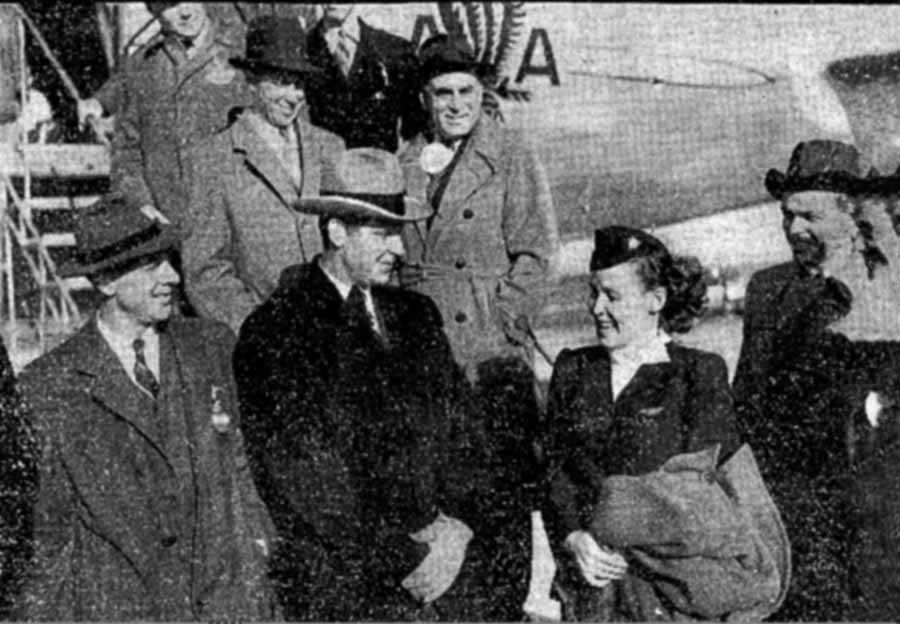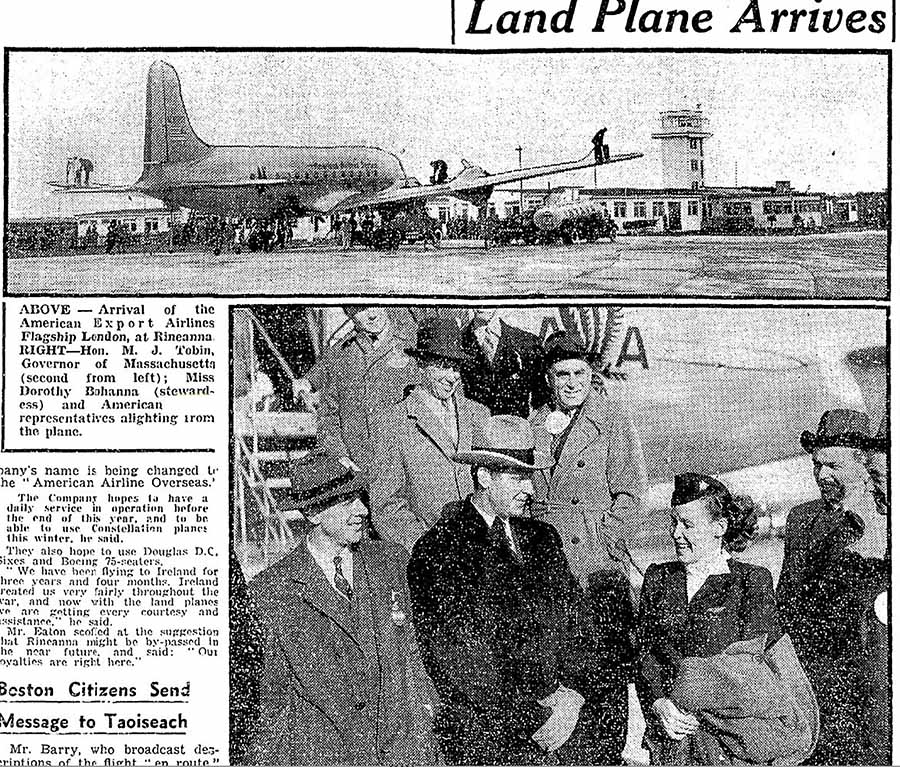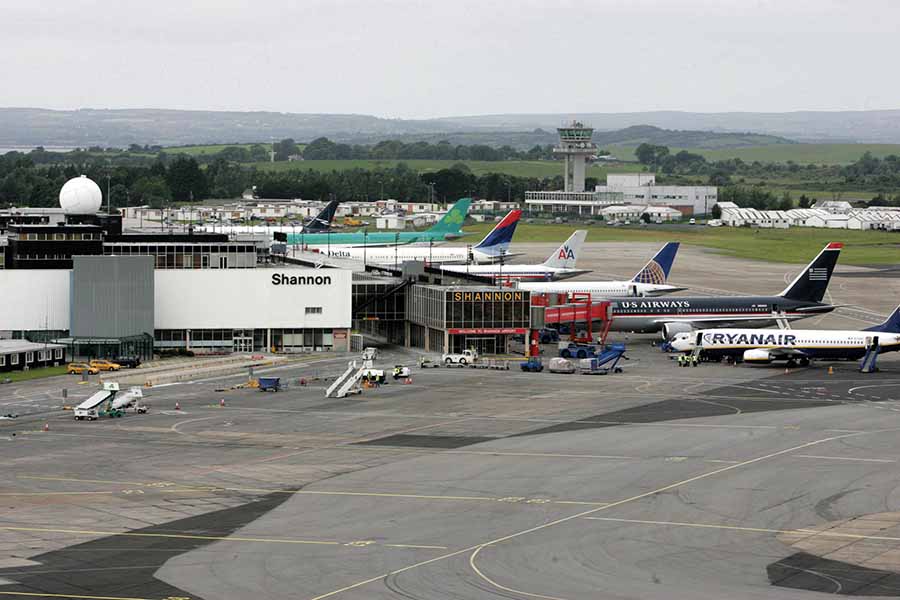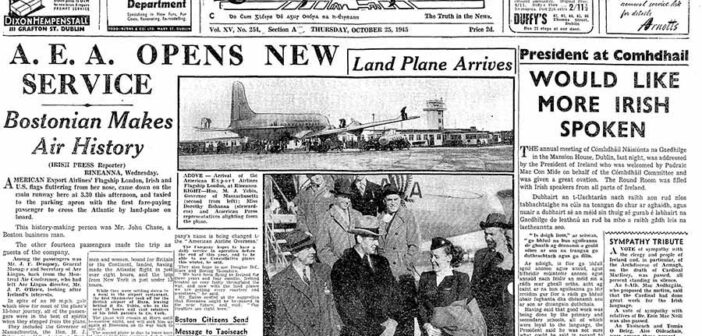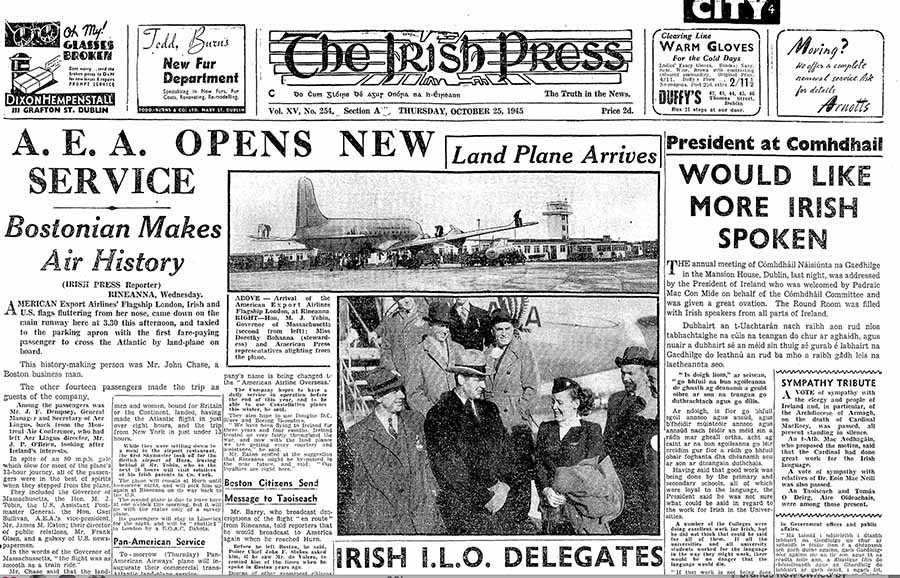
On October 24, 1945, an American Overseas Airlines (AOA) DC-4 touched down at Shannon Airport in Ireland, marking the first commercial flight to land at the south Clare location, Rineanne, the realm of the birds. This event was a pivotal moment in the history of aviation, particularly in the development of transatlantic air travel.
The landing of the DC-4 was not merely a singular achievement but the culmination of decades of technological advancements, geopolitical shifts, and economic necessities driven by the aftermath of World War II. This essay explores the lead-up to this historic flight, the technological developments and post-war circumstances that made it possible, its significance in aviation history, and its role in shaping the subsequent development of transatlantic air travel.
The arrival of the American Overseas Airlines DC-4 at Shannon Airport on October 24, 1945, was a defining moment in aviation history. It marked the beginning of regular land-based transatlantic commercial flights, made possible by a combination of technological advancements, wartime innovations, and post-war economic and geopolitical circumstances. The flight highlighted Shannon’s strategic importance as a transatlantic hub and set the stage for the rapid expansion of global air travel in the decades that followed.
The significance of this event extends beyond the technical achievement of the flight itself. It represented a shift toward a more connected world, where air travel became a vital link for commerce, culture, and diplomacy.
The legacy of the AOA DC-4 flight can be seen in the modern aviation industry, where transatlantic flights are a routine part of global connectivity. Shannon Airport, born out of Ireland’s vision to bridge continents, remains a testament to the enduring impact of that historic day in 1945. As aviation continues to evolve, the story of the first commercial flight to Shannon serves as a reminder of the ingenuity, ambition, and collaboration that have shaped the skies.
Realm of the birds
The establishment of Shannon Airport as a hub for transatlantic flights was rooted in a combination of geographic advantage, political strategy, and wartime developments. Located on the west coast of Ireland, Shannon was ideally positioned as a gateway between Europe and North America. Its proximity to the Atlantic Ocean made it a natural stopover point for aircraft crossing the ocean, especially in an era when aircraft range was limited.
Before World War II, transatlantic air travel was in its infancy. Early attempts at crossing the Atlantic by air, such as Alcock and Brown’s historic non-stop flight in 1919, were feats of daring rather than practical transportation. By the 1930s, flying boats like the Pan American Airways’ Boeing 314 Clipper offered limited commercial service across the Atlantic, but these were expensive, exclusive, and weather-dependent. Land-based aircraft, constrained by range and reliability, were not yet viable for regular transatlantic passenger service.
The outbreak of World War II in 1939 accelerated aviation technology and infrastructure development. Ireland, maintaining neutrality during the war, became a strategic location for aviation. The nearby Foynes seaplane base, located on the Shannon Estuary, served as a key stopover for flying boats during the war, including those operated by Pan American Airways and Britain’s Imperial Airways (later BOAC). Foynes was a critical link in the transatlantic chain, but its limitations as a seaplane base highlighted the need for a modern land-based airport.
In 1942, the Irish government began constructing Rineanna Airport (later renamed Shannon Airport) to replace Foynes and accommodate land-based aircraft. The airport’s development was driven by Ireland’s desire to capitalize on its geographic position and establish itself as a hub for international aviation. By 1945, the airport was ready to receive its first commercial flight, setting the stage for the AOA DC-4’s historic landing.
Technological Developments
The AOA DC-4 that landed at Shannon on October 24, 1945, was a product of significant technological advancements in aircraft design and navigation. The Douglas DC-4, a four-engine propeller-driven aircraft, represented a leap forward in aviation technology. Developed in the late 1930s, the DC-4 was designed to carry more passengers over longer distances than its predecessors, such as the DC-3. With a range of approximately 2,500 miles, the DC-4 was well-suited for transatlantic flights, particularly with a stopover in Shannon to refuel.
Several key technological developments made the DC-4 and the Shannon landing possible. The DC-4 was a robust, reliable aircraft capable of carrying up to 44 passengers in its commercial configuration. Its four Pratt & Whitney R-2000 engines provided the power needed for long-distance flights, while its pressurized cabin (in later models) improved passenger comfort at higher altitudes. The DC-4’s ability to operate from relatively short runways, such as those at Shannon, was critical for early transatlantic routes.
Transatlantic flights required precise navigation over vast stretches of ocean, where landmarks were nonexistent. By 1945, advancements in radio navigation, including the use of radio beacons and direction-finding equipment, allowed pilots to navigate more accurately. The establishment of ground-based navigation aids at Shannon and other key airports facilitated safe and reliable transatlantic operations.
The construction of Shannon Airport itself was a technological achievement. The airport featured a long runway capable of accommodating large aircraft like the DC-4, as well as modern facilities for passenger handling and aircraft maintenance. Shannon’s infrastructure was designed to support the growing demand for transatlantic air travel, making it an ideal destination for the first commercial flight.
World War II drove rapid advancements in aviation technology. Military aircraft like the C-54 Skymaster (the military version of the DC-4) were used extensively for long-range transport missions, proving the reliability of four-engine aircraft. These wartime experiences informed the design and operation of commercial aircraft like the DC-4, which benefited from lessons learned in combat.
Post-War Circumstances
The end of World War II in 1945 created a unique set of circumstances that enabled the first commercial flight to Shannon. The post-war environment was characterized by a surge in demand for international travel, a surplus of aircraft and trained personnel, and a geopolitical landscape that favored the expansion of commercial aviation.
The war had disrupted global travel, but its conclusion unleashed pent-up demand for passenger and cargo transport. Business travelers, government officials, and immigrants sought to reconnect across the Atlantic, creating a market for commercial air services. Shannon, as a gateway to Europe, was well-positioned to capitalize on this demand.
The war left behind a surplus of military aircraft, many of which, like the C-54, were converted for civilian use. Similarly, thousands of trained pilots, navigators, and mechanics were available to transition into commercial aviation. American Overseas Airlines, a subsidiary of American Airlines, leveraged these resources to launch its transatlantic operations, with the DC-4 as its flagship aircraft.
The post-war period saw the establishment of international agreements that facilitated commercial aviation. The 1944 Chicago Convention laid the groundwork for modern air traffic regulations, including the designation of “freedoms of the air” that governed international routes. Ireland’s neutrality during the war allowed it to negotiate favorable agreements with the United States and other countries, positioning Shannon as a key stopover point.
The Irish government recognized the economic potential of aviation and actively promoted Shannon as a transatlantic hub. The establishment of the Shannon Free Zone in 1959 (a later development) built on this vision, but even in 1945, Ireland saw the airport as a means to boost tourism, trade, and economic growth. The first commercial flight was a step toward realizing this ambition.
The landing of the AOA DC-4 at Shannon on October 24, 1945, was a landmark event in aviation history for several reasons. It marked the beginning of regular, land-based transatlantic commercial flights, a shift from the earlier reliance on flying boats. This transition democratized air travel, making it more accessible to a broader range of passengers and paving the way for the modern aviation industry.
The Shannon landing signaled the start of a new era in which land-based aircraft could reliably cross the Atlantic. Unlike flying boats, which were limited by weather and required specialized infrastructure, the DC-4 and similar aircraft could operate year-round from standard airports. This reliability was crucial for establishing scheduled transatlantic services.
The flight cemented Shannon’s status as a critical stopover point for transatlantic flights. For much of the late 1940s and 1950s, Shannon was a mandatory stop for many transatlantic routes due to the range limitations of early aircraft. The airport’s strategic location made it a linchpin in the global aviation network.
The success of the AOA flight demonstrated the viability of long-haul commercial air travel. Airlines like Pan American, TWA, and BOAC soon expanded their transatlantic operations, competing to offer faster and more comfortable services. The DC-4’s role in this expansion highlighted the potential of four-engine aircraft to transform global connectivity.
Ireland and the world
The flight had broader implications for Ireland and the world. For Ireland, Shannon became a symbol of modernity and a gateway to international markets. The airport’s duty-free shop, established in 1947, was the world’s first, further enhancing Shannon’s reputation as an innovative aviation hub. Globally, the flight underscored the growing importance of air travel in fostering cultural exchange and economic integration.
The first commercial flight to Shannon set the stage for the rapid development of transatlantic aviation in the decades that followed. The success of the AOA DC-4 flight spurred technological, operational, and economic advancements that transformed air travel into a cornerstone of global connectivity.
The DC-4 was soon surpassed by more advanced aircraft, such as the Lockheed Constellation and the Boeing 707. The introduction of jet aircraft in the late 1950s, particularly the Boeing 707 and Douglas DC-8, revolutionized transatlantic travel by reducing flight times and eliminating the need for stopovers like Shannon. These jets could fly non-stop between North America and Europe, making transatlantic travel faster and more efficient.
The success of early transatlantic flights encouraged airlines to expand their routes and fleets. By the 1950s, major carriers like Pan Am, TWA, and BOAC were offering regular transatlantic services, with Shannon remaining a key hub for many routes. The growth of competition drove down fares, making air travel more accessible to the middle class.
Transatlantic air travel facilitated the post-war economic boom by connecting markets, fostering tourism, and enabling business travel. The “Jet Age” of the 1960s further accelerated this trend, with millions of passengers crossing the Atlantic annually. Shannon played a role in this expansion, particularly as a hub for cargo and passenger flights.
While the introduction of long-range jets reduced the need for stopovers, Shannon adapted to remain relevant. The establishment of the Shannon Free Zone attracted international businesses, while the airport continued to serve as a hub for cargo and transatlantic flights. Today, Shannon remains an important airport for both commercial and military aviation, with a legacy rooted in the 1945 AOA flight.
The growth of transatlantic aviation prompted further international cooperation. The International Air Transport Association (IATA) and the International Civil Aviation Organization (ICAO) emerges to play key roles in standardizing regulations and ensuring safety. The “Open Skies” agreements of the 1990s further liberalised transatlantic routes, allowing airlines greater flexibility to compete.
